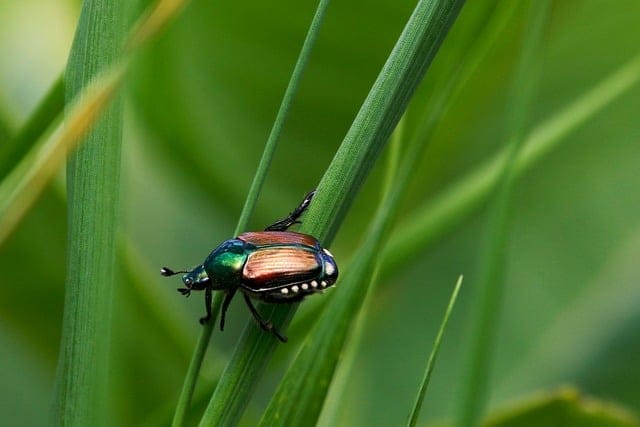Fighting gardening pests: Japanese beetles
Japanese beetles (Popillia japonica) are invasive pests that can wreak havoc in your garden

In this article:
- Introduction to Japanese Beetles
- Identifying Japanese Beetles and their Destructive Impact
- Understanding the Life Cycle of Japanese Beetles
- Signs and Symptoms of Japanese Beetle Infestation
- Preventing Japanese Beetle Infestations
- Natural Methods for Controlling Japanese Beetles
- Chemical Control Options for Japanese Beetles
- Integrated Pest Management: Combining Strategies for Effective Control
- Protecting Your Garden Plants from Japanese Beetles
- Removing Japanese Beetles from Your Garden
- Managing Japanese Beetle Grubs in Lawns
- Dealing with Japanese Beetles: Common Mistakes to Avoid
- Frequently Asked Questions about Japanese Beetles
- Conclusion: Maintaining a Healthy Garden despite Japanese Beetles
Introduction to Japanese Beetles
Japanese beetles (Popillia japonica) are invasive pests that can wreak havoc in your garden. Originally from Japan, these metallic green beetles have become a significant problem in many parts of the United States. In this article, we will explore the identification, life cycle, impact, prevention, and control methods for Japanese beetles, enabling you to protect your plants from their destructive feeding habits.
Identifying Japanese Beetles and their Destructive Impact
Japanese beetles are easily identifiable due to their distinct metallic green coloration with bronze wing covers. They are approximately half an inch in length, and their larvae are C-shaped, cream-colored grubs. These grubs can cause substantial damage to the roots of your lawn, while adult Japanese beetles devour the foliage, flowers, and fruits of many different plant species. Understanding the destructive impact they have on your garden is crucial for effective control.
Understanding the Life Cycle of Japanese Beetles
Knowing the life cycle of Japanese beetles is important for planning effective control strategies. From their egg-laying stage to the development of grubs and finally, their emergence as adult beetles, understanding each phase allows you to target vulnerable points in their life cycle and limit their population growth.
Signs and Symptoms of Japanese Beetle Infestation
Recognizing the signs and symptoms of a Japanese beetle infestation early on can prevent extensive damage to your plants. Look out for skeletonized leaves, wilting plants, damaged flowers, and the presence of adult beetles or grubs. Early detection is key to minimizing the impact of these voracious pests.
Preventing Japanese Beetle Infestations
Prevention is always better than cure when it comes to Japanese beetles. Implementing proactive measures such as selecting resistant plant varieties, practicing good garden hygiene, and using physical barriers can help prevent infestations in the first place. Taking preventive action can save you time, effort, and frustration down the line.
Natural Methods for Controlling Japanese Beetles
If you prefer to use organic and environmentally friendly methods to control Japanese beetles, there are several options available. From introducing beneficial insects to your garden to using homemade sprays or traps, natural control methods can be highly effective in reducing Japanese beetle populations without causing harm to your plants or the environment.
Chemical Control Options for Japanese Beetles
In situations where pests reach intolerable levels or natural methods prove insufficient, chemical control options may be necessary. By understanding the available insecticides and their proper application, you can effectively target Japanese beetles while minimizing risks to beneficial insects and other wildlife.
Integrated Pest Management: Combining Strategies for Effective Control
Integrated Pest Management (IPM) involves combining various strategies to achieve long-term and sustainable control of Japanese beetles. By integrating cultural, physical, biological, and chemical control methods, IPM provides a holistic approach that focuses on minimizing economic, environmental, and health risks.
Protecting Your Garden Plants from Japanese Beetles
Implementing specific protection measures for your garden plants can help deter Japanese beetles and reduce the damage they cause. By using physical barriers, such as row covers or nets, and applying repellents or deterrents, you can give your plants the best chance at thriving despite the presence of these pests.
Removing Japanese Beetles from Your Garden
When you notice Japanese beetles in your garden, taking immediate action to remove them manually can help prevent further feeding damage. Handpicking adults from plants, utilizing shake-and-drop techniques, or using soapy water traps are effective methods for physically removing Japanese beetles from your garden.
Managing Japanese Beetle Grubs in Lawns
The grubs of Japanese beetles can cause significant damage to lawns by feeding on grass roots. Understanding their life cycle and adopting appropriate management techniques, such as soil treatment, cultural practices, or biological control mechanisms, can help prevent and control grub infestations, ensuring a healthy and lush lawn.
Dealing with Japanese Beetles: Common Mistakes to Avoid
When it comes to Japanese beetle control, there are common mistakes that gardeners should avoid. Whether it's ineffective control methods, misidentifying the pest, or using improper timing, understanding these pitfalls ensures that your efforts are not in vain and that you achieve the best results in combating Japanese beetles.
Frequently Asked Questions about Japanese Beetles
Still have questions about Japanese beetles? This section answers some common queries that gardeners often have regarding identification, prevention, control methods, and potential risks associated with these pests. Educating yourself about Japanese beetles will enable you to make informed decisions and take effective action.
Conclusion: Maintaining a Healthy Garden despite Japanese Beetles
While Japanese beetles can be a formidable adversary for gardeners, armed with knowledge and the appropriate control strategies, you can keep their populations in check and protect your precious plants. By combining preventive measures, natural and chemical control methods, and adopting a comprehensive IPM approach, you can maintain a healthy and vibrant garden, free from the destructive impact of Japanese beetles.
